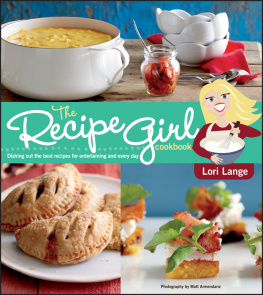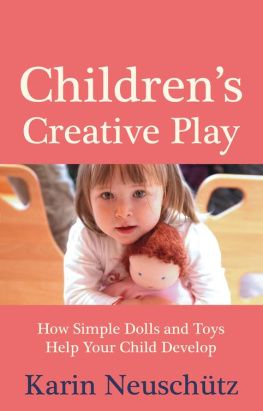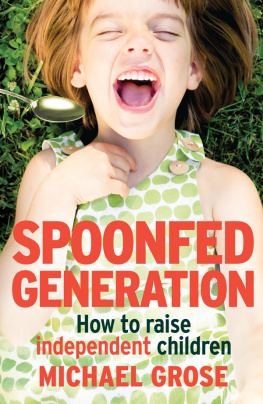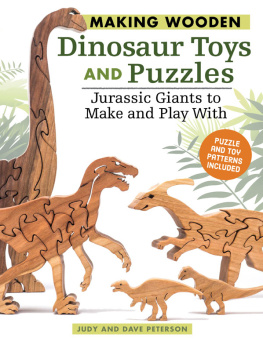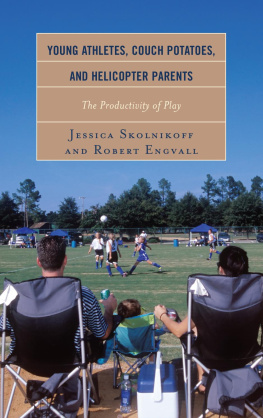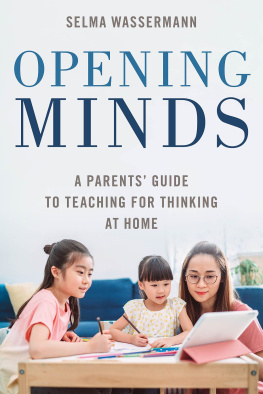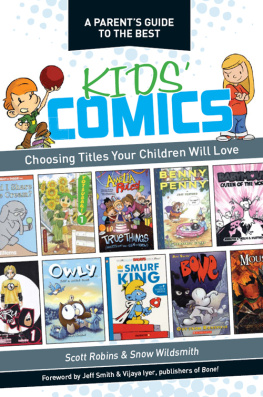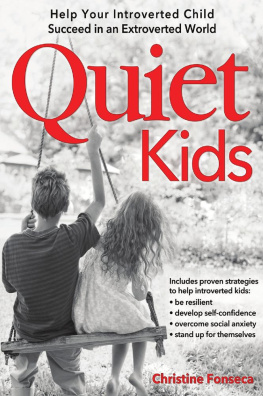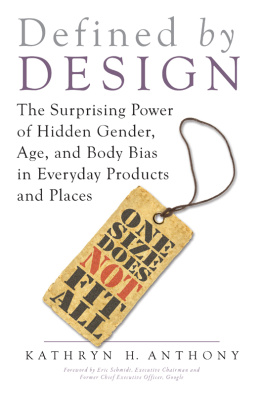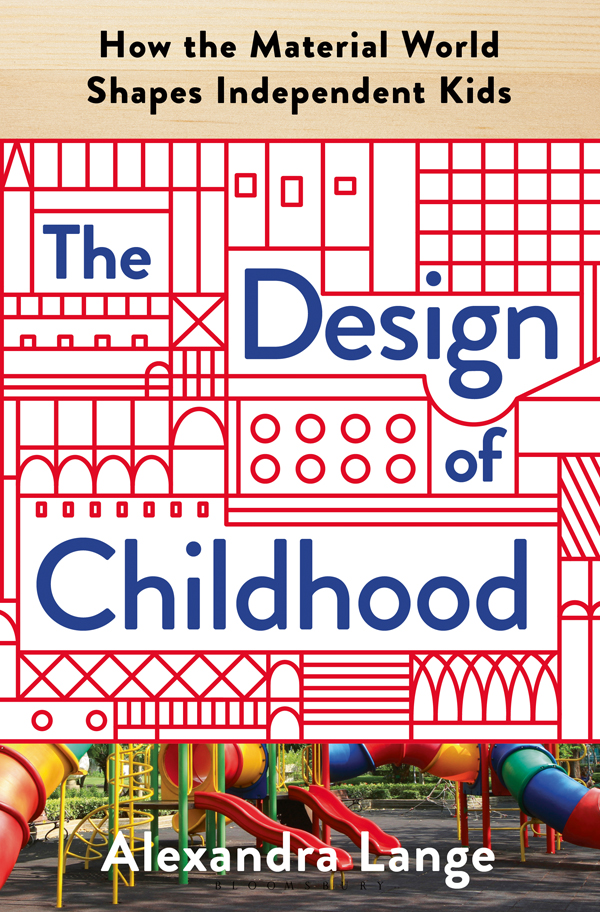Contents
Guide
Pagebreaks of the print version


To Paul and Romy, who opened my eyes
ALSO BY ALEXANDRA LANGE
Design Research: The Store That Brought Modern Living to American Homes (with Jane Thompson)
Writing about Architecture: Mastering the Language of Buildings and Cities
The Dot-Com City: Silicon Valley Urbanism


CONTENTS
In 1924, Lillian Moller Gilbreth found herself a widow with eleven children. She and her late husband, Frank Gilbreth, were the inventors of motion study, breaking tasks down into minute component parts to figure out how to speed up repetitive tasks and reduce worker fatigue. The couple was also the subject of Cheaper by the Dozen , a 1948 bestselling biographical novel written by two of those children. While Frank Gilbreth was alive, he and Lillian worked for industries ranging from construction to medicine to rehabilitation. Lillian had a PhD in psychology, and she eventually became the second woman member of the American Society of Mechanical Engineers and the first female engineering professor at Purdue University. She wrote or co-wrote many of Franks books, often anonymously, as it was thought that a womans byline might undermine their authority. After Franks sudden death, even longtime clients were reluctant to renew their contracts with her alone, and she had to reestablish herself as a sole female practitioner. Unwilling to let Gilbreth, Inc. perish with its male founderand still needing to provide for her childrenshe did just what many professional women of the present day do when presented with an obstacle: She pivoted.
First, she established a course in motion study, headquartered at her Montclair, New Jersey, home and office.
Her kitchen plans got her a contract with General Electric, then coverage in the newspapers, and then an offer by a newsreel company to film this unicorn, a woman engineer with eleven children, baking an apple cake in her efficiency kitchen. The cake was a must, as it was the only dish Gilbreth could prepare: Her family had employed a cook during her childhood, and the Gilbreth household had included a couple of servants so that both parents could work. Studying films of women in their kitchens, Gilbreth counted the number of steps required to walk from pantry to stove to sink and the number of operations required to measure, stir, bake, and wash up while making a cake. She then rearranged the elements of the kitchen to put stove and prep counter side by side, with ingredients stored above, pans below, and the refrigerator nearby. A cart within arms reach provided a second work surface and could be wheeled over to the sink when the task was done. The arrangement was L shaped, one of three efficient setups used in most contemporary kitchens, where a fixed island typically replaces the cart. (My kitchen is a U, yours may be a C.) Though her biographer Jane Lancaster points out that
Gilbreth saw an opportunity where others did not, turning sexism to her advantage. Even while Frank was alive the Gilbreths had seen the home as a site of labor, and they applied four critical eyes to repetitive everyday tasks. Dad believed that most adults stopped thinking the day they left schooland some even before that. A child, on the other hand, stays impressionable and eager to learn. Catch one young enough, Dad insisted, and theres no limit to what you can teach, wrote the younger Gilbreths in Cheaper by the Dozen . Though Frank and Lillian used their children to demonstrate that motion study could be childs play, it wasnt until Lillian was faced with the possibility of a world without work outside the home that she turned her research within those wallsand designed her own escape hatch.
Cheaper by the Dozen has always been one of my favorite childrens books, but it wasnt until I began to write my own book about children that I figured out why. Frank Gilbreths attitude toward raising kids came across as entirely modern. He saw them as little sponges, to be spoken to as adults and provided with the tools to teach themselves. Their eagerness to learn was a better approximation of his own lust for learning than the spirit of most workaday adults. Lillian Gilbreths career transformation, in widowhood, planted an early clue that critical thinking could be applied to toothbrushing as well as production lines. As a tidy little girl who wanted a place for everything, I loved the idea that there was a better way to do anything, and I became conscious of my own movements and arrangements. When I cook dinner using a minimum number of bowls, cutting boards, and pans, I think of Lillian. When in my early thirties I finally had the chance to design my own kitchen, multiple childhood readings of Belles on Their Toes made mapping a work triangle a snap. A childrens book taught me most of what I needed to know.
More personally: When I had a child, I found myself more focused at home than on the distant architecture that had been my topicpartly by choice, partly because the 2008 recession eliminated much of my freelance work. But even as I happily played with my son, I couldnt turn my critical mind off. At first it was the construction site on the carpet: I am a design critic married to an architect, so naturally our baby gifts included three or four different sets of building blocks, in cardboard, foam, and wood. Was one set better than the other? Who chose the colors, the sizes, the illustrated fruits? As he became more mobile, it was the high chair and the stroller: Do we buy the one he needs now, or can we find one that will grow with him? As we explored the neighborhood, I wondered why the playgrounds bulbous plastic parts seemed so different from the metal-frame geodesic dome that I climbed in my own backyard. He went to school and the classroom was arranged not in rows of tiny desks but in sections: block corner here, child-size tables and chairs there, a rug beyond, even though the building itself seemed made for kids in grids. Navigating the city with a baby carrier and then a stroller (and then a stroller and a preschooler) I was suddenly aware of curb cuts and subway elevators, of small parks in which one could rest, and streets so wide we never made it across before the countdown clock ended.
To have a
I came to see each successive stage of childhood development as an opportunity for encounters with larger and more complex environments; as each challenge is met, the child needs to find another within her grasp and set herself the task of mastery. (Because so many of the texts I consulted were written before 1970 and refer to the child solely as a he, Im going to take the opposite tack in my text.) Malaguzzi is far from alone in this belief in child-led and object-oriented learning. Psychologist Jean Piaget, whose theory of the child mind came to dominate late twentieth-century education, theorized that knowledge has to be learned from experiences, like by putting a block under a blanket and then finding that it still exists, or, in a later stage, by dropping blocks from different heights and seeing what happens. Through active experiment children construct their understanding of the worldjust one of tens of building metaphors embedded, almost subconsciously, in the language of childhood.




